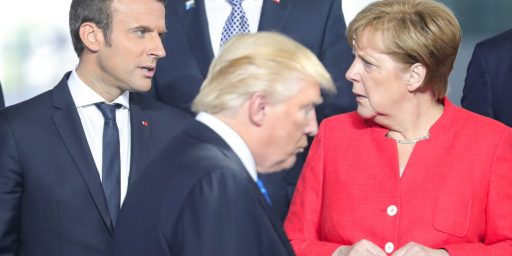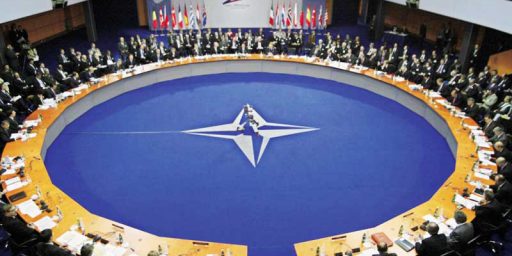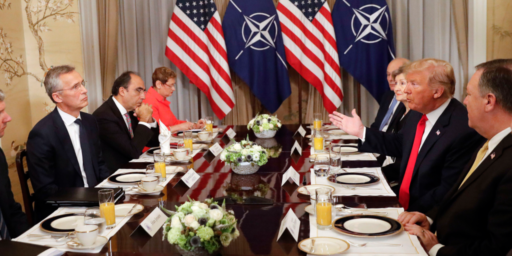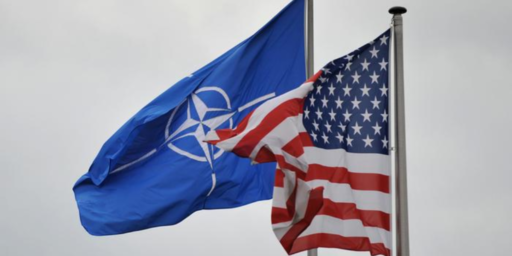New Years View From Europe on NATO
Providing Peace in Our Time on Our Continent
In Europe the end of 2006 is a time to reflect on the prospects for peace in our time on our continent. It is also a time to reflect on whether the United States will continue to safeguard Europe and Europe’s interests and at what cost? The Cold War is long past and Russia is not the same threat that the Soviet Union posed — but is Europe capable of defending itself? It is almost a decade since the last war between nation-states on the European continent — in the Balkans. The Kosovo campaign in 1998 to prevent a genocide was only possible with American armed forces — European states were both unable and unwilling to intervene.
The Balkans are now a focus for both NATO and EU enlargement. Albania, Croatia and the former Yugoslav Republic of Macedonia – are members of NATO’s Membership Action Plan (MAP), designed to assist aspiring partner countries meet NATO standards and prepare for possible future membership. Croatia and Turkey are EU candidate countries. They started accession negotiations on 3 October 2005. In December 2005, the European Council granted the former Yugoslav Republic of Macedonia the status of a candidate country. All the other Western Balkan countries are potential candidate countries: Albania, Bosnia and Herzegovina, Montenegro, and Serbia including Kosovo under UN Security Council Resolution 1244. A new Instrument for Pre-Accession (IPA) aims to provide targeted pre-accession assistance both to candidate countries and to potential candidates. This leaves a focus on those countries between the EU and Russia. These have internal disputes but are not considered likely to wage war against any other state. Even terrorism seems to be held at arms length. The last significant terrorist event was in July 2005 on the London Underground. Such optimism for peace also opens the door for concern. Security mandarins are apprehensive that the longer it has been since a last terrorist attack or a war means that the sooner will be the next terrorist attack or war. So what is the status of planning, of risk management, of preparation? There are four areas which may be focussed upon. The individual states on the European continent, the EU, NATO and the UN. This brief will focus on NATO. NATO is probably the most formidable armed force on the European continent as led by the United States.
At the fore of European defense and security for almost the last 60 years has been NATO. A few weeks ago a new Supreme Allied Commander Europe (SACEUR) was appointed. The position is now filled by General John Craddock as it is traditional for a United States Flag or General officer to do so. He is dual-hatted as Commander of the US European Command. His NATO command is exercised from the Supreme Headquarters Allied Powers Europe (SHAPE) at Casteau, Mons, Belgium. He is responsible to NATO’s Military Committee, the highest military authority in NATO, for the conduct of all NATO military operations. He is the 15th SACEUR since the creation of the position when NATO was formed and the 12th that comes from the US Army — there have been two from the US Air Force and one from the US Marine Corp. Each SACEUR has his own style of command, preferences and priorities. Only time will tell the impact of General John Craddock on European defence and security. However not all European states, especially not France, are happy that such a senior post is being held by an American.
His appointment comes shortly after a significant NATO summit in November in Riga. A brief look at NATO’s past Summits reveals how closely the Alliance’s evolution and the United States has been intertwined with Europe’s maturation into an undivided and democratic security zone. The London Summit of 1990 declared the Cold War over and offered a hand of friendship to the East. The Rome Summit of 1991 defined the contours of a new NATO, including a new Strategic Concept. The Brussels Summit of 1994 gave this new NATO a more concrete agenda, including potential enlargement and new mechanisms for security cooperation throughout the entire Euro-Atlantic area. In 1997 the NATO-Russia relationship was created on a solid institutional foundation and the Madrid Summit of the same year issued invitations to three new members as well as reaching out to Ukraine. At the Washington Summit in 1999 much of the NATO crisis management experience from the Balkans was codified, and looked to the future with a new, much broader Strategic Concept which added crisis management and Partnership to NATO’s principal task of collective defence. At the Prague Summit of 2002, seven additional countries were invited to join NATO, and the Organization changed even more substantially in order to cope with the new 21st century security challenges, especially terrorism. Finally, the Istanbul Summit of 2004 reinforced NATO’s commitment to building peace in Afghanistan and opened a new chapter of cooperation with countries from the broader Middle East region.
At the Riga Summit, on 28 and 29 November, NATO Secretary General Jaap de Hoop Scheffer announced that NATO’s cutting-edge Response Force is at full operational capability. The NATO Response Force is a highly ready and technologically advanced force that includes a brigade-size land component with forced-entry capability; a naval task force including a carrier battle group, an amphibious task group and a surface action group; and an air component capable of 200 combat sorties a day. It is capable of performing missions worldwide across the whole spectrum of operations. These include evacuations, disaster management, counterterrorism, and acting as ‘an initial entry force’ for larger, follow-on forces. It can number up to 25,000 troops and start to deploy after five days’ notice and sustain itself for operations lasting 30 days or longer if resupplied. “We are there,” NATO Secretary General Jaap de Hoop Scheffer told reporters, “A major accomplishment because it gives the Euro-Atlantic community unprecedented capability.”
The NRF is put together from force elements which Allies volunteer well in advance to meet particular requirements – a framework for Partner involvement in the NRF is being developed. After preparation at a national level, a six-month NATO training programme starts after which the force is certified to the highest standards. It is then put on “stand-by” for six months. An NRF rotation therefore consists of both the training period and the stand-by period. This NATO NRF makes a significant step towards the formation of a force able and capable of preventing and if need be intervening in such situations that gave rise to conflict in the Balkans during the 1990s. It is able to dissuade and to deter conflict between states on the European continent as well as being at the fore of protecting Europe’s external borders. However the NRF relies heavily on American logistic capability, financing and indeed the core of the force contribution.
The Riga summit also endorsed greater political unity – being the first Summit in one of the countries that joined the Alliance in the last enlargement round of 2004. The NATO Heads of State and Government endorsed the Comprehensive Political Guidance, a major policy document that sets out the priorities for all Alliance capability issues, planning disciplines and intelligence for the next 10 to 15 years. The Guidance analyses the probable future security environment, acknowledging the possibility of unpredictable events. It recognizes that for the foreseeable future, the principal threats to the Alliance are terrorism and proliferation, as well as failing states, regional crises, misuse of new technologies and disruption of the flow of vital resources. Against that analysis, it sets out the kinds of operations the Alliance must be able to perform and the kinds of capabilities the Alliance will need. The Guidance underlines the requirement for NATO’s forces to remain balanced, flexible and agile, able to conduct the full range of its missions, from high to low intensity, but emphasizes the likelihood that NATO will need to carry out a greater number and range of smaller operations. Among the different requirements outlined, the document defines NATO’s top priorities, starting with joint expeditionary forces and the capability to deploy and sustain them. The Guidance supports the Alliance’s 1999 Strategic Concept; it does not replace it. At the Riga Summit the NATO Allies also gave positive response to Ukraine’s, as well as to Georgia’s, declared interest in joining the Alliance. The idea of a NATO Training Initiative for the broader Middle East region received widespread support and interest was expressed to further enhance an outreach program to partners in the Mediterranean Dialogue and Istanbul Cooperation Initiative. Support was also voiced for African Union peacekeeping, and energy security.
In making such political and military statements, supported by actions, NATO under American leadership and as the major contributor has ensured that it will remain a formidable mechanism to ensure peace in our time on our continent throughout 2007 and beyond. Most significantly and notably there are 19 European countries that have common membership of both the EU and NATO. In this NATO is a reflection both of a large segment of European voices and opinions as well as a reflection of trans-Atlantic unity. Such unity portrays the common values that exist between European Union states, Canada and the United States indicative of a global defence and security community.
_______
Glen Segell is Director of the London Based Institute of Security Policy. He has published over 15 books and articles. He received his education at Hebrew University Jerusalem and King’s College London and has held positions at the University of the Witwatersrand, University of Reading, Centre for Defence Studies and IHR.





